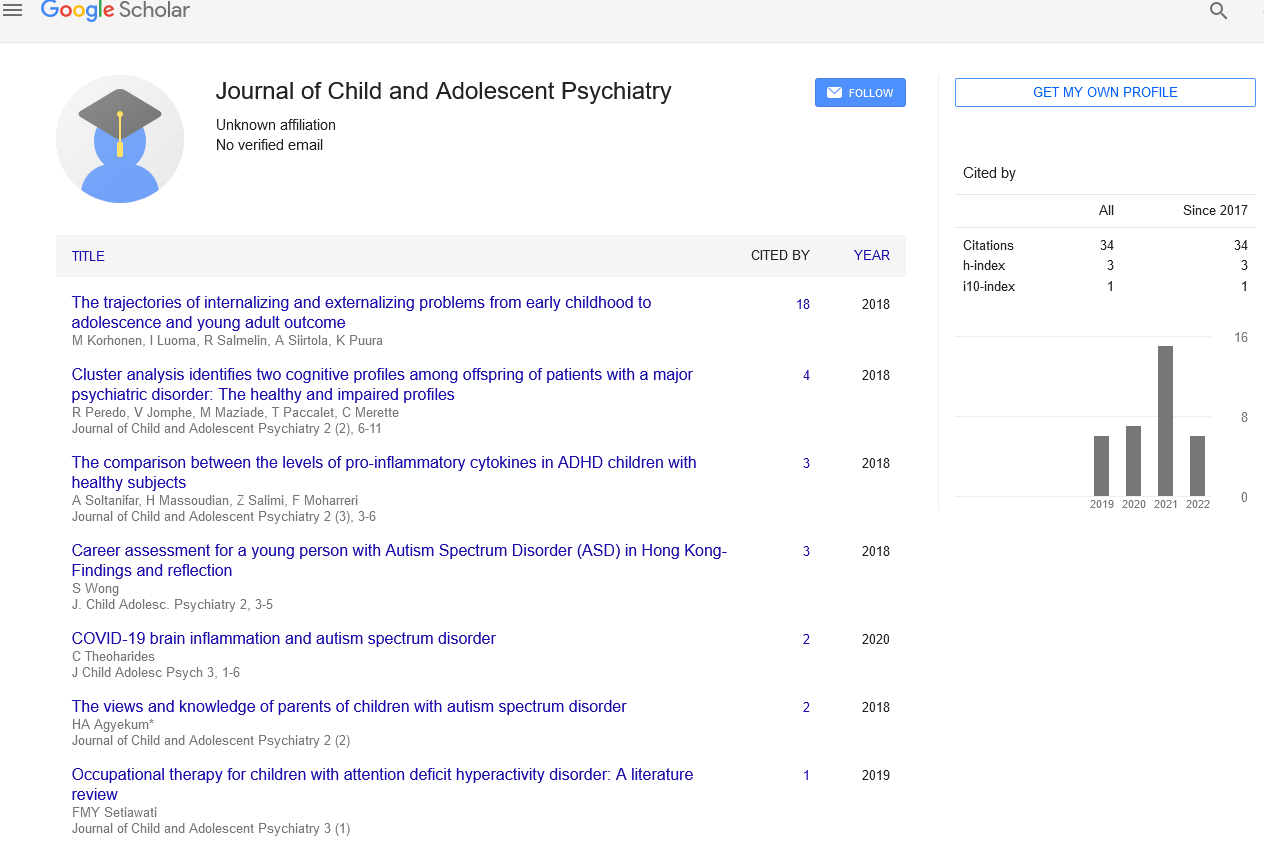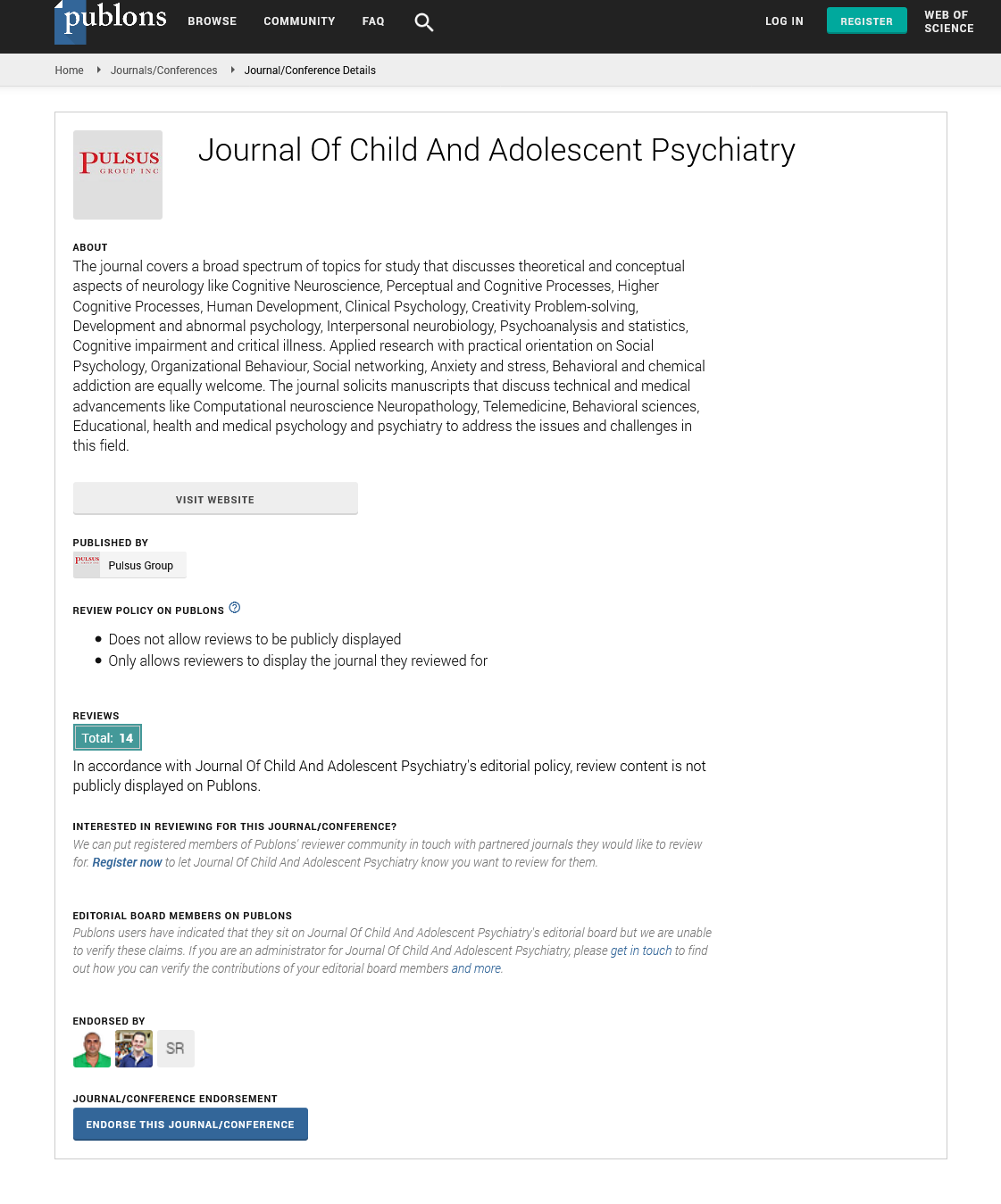Unusual Eating Habits in Children
Received: 21-Jan-2022, Manuscript No. PULJACP-22-4725; Editor assigned: 23-Jan-2022, Pre QC No. PULJACP-22-4725(PQ); Accepted Date: Apr 16, 2022; Reviewed: 27-Jan-2022 QC No. PULJACP-22-4725(Q); Revised: 03-Mar-2022, Manuscript No. PULJACP-22-4725(R); Published: 13-Mar-2022, DOI: 10.37532/puljacp.2022. 6(2)-20-21
This open-access article is distributed under the terms of the Creative Commons Attribution Non-Commercial License (CC BY-NC) (http://creativecommons.org/licenses/by-nc/4.0/), which permits reuse, distribution and reproduction of the article, provided that the original work is properly cited and the reuse is restricted to noncommercial purposes. For commercial reuse, contact reprints@pulsus.com
Abstract
Although there is no universal definition of picky eating, it is often applied to children who consume a limited amount of food, have strong dietary preferences, limit their intake (especially of vegetables), and refuse to try new foods. Picky eating is a behavioral issue that affects a large number of people. Recent research has discovered that picky eating is not linked to developing an eating disorder and has no influence on growth. pressure- associated persistent fitness issues.
Commentary
Because there is no commonly acknowledged definition of picky eating, it is impossible to account for its prevalence. Picky eating was found to be 26.5% at 18 months of age, 27.6% at 3 years of age, and 13.2% at 6 years of age in a recent study including 4,018 individuals in the Netherlands. Picky eating is generally a transient trait in preschool children, according to the findings, and is a natural part of their growth. Ecological elements assume a part in taste and eating inclinations. Flavors from fragrant mixtures got from maternal food utilization are communicated into the amniotic liquid and bosom milk; these flavors have solid impacts on taste inclinations and food acknowledgment further down the road. A trial concentrated on showed that babies of moms who drank carrot juice during the last trimester of pregnancy delighted in carrot-enhanced grains more than babies whose moms didn't drink carrot squeeze or eat carrots. Human milk is made out of flavors that are an impression of food drank by the bosom taking care of moms. A fluctuated diet in bosom taking care of moms delivers more flavor openness and encounters in kids, which might assist with making sense of why breastfed babies are not so much finicky but rather more able to attempt new food sources. This thought was likewise upheld in a new report, wherein 127 kids who were solely breastfed for quite some time were seen to have lower chances of fostering an inclination for food to be ready with a specific goal in mind by 78%, food dismissal by 81%, and aversion of new food (neophobia) by 75%. Hereditary qualities likewise assume a part in demanding eating. Early inclinations for sweet taste have been seen in babies. Then again, harsh taste is intrinsically despised, potentially because of a defensive system since most unpleasant mixtures are harmful. Henceforth, neophobia might be a transformative defensive instrument, effectively shielding kids from ingesting possibly harmful substances. These inborn food inclinations might become boundaries for acknowledgment of specific food. A review including 5,390 sets of twins from 8 to 11 years old proposed that neophobia is an exceptionally heritable characteristic, meaning a youngster's hesitance to attempt new food might be halfway because of hereditary qualities and not parental practices. There are numerous ways of advancing food acknowledgment among kids. Moms (especially the individuals who don't plan to breastfeed) are prescribed to eat an assortment of food during their pregnancy and afterward open their youngsters to an assortment of food at an early age. Kids might display typical exploratory ways of behaving with new food sources like contacting, smelling, playing, placing food varieties in their mouth, and afterward letting them out before they will taste and swallow different food sources. Rehashed taste openness and demonstrating ways of behaving in a non-coercive design have displayed to increment food acknowledgment. Alternately, compelling youngsters to eat can make them loathe those food varieties. Specialists in an investigation of 3,022 newborn children observed that numerous parental figures didn't know that their babies and babies required upwards of 8-15 openings to a specific food before they acquired acknowledgment of that food. Expanded acknowledgment and utilization of ineffectively preferred food by youngsters, for example, supplement-rich products of the soil can be accomplished by offering kids tiny preferences of new and recently detested foods grown from the ground. Food is additionally more promptly acknowledged in small kids when others around them are eating a similar sort of food. Such demonstration emphatically features the happiness regarding such food sources. Commending kids for attempting new food and giving them little symbolic prizes, like stickers (however not treats) additionally increments acknowledgment. A few creators have contended that giving compensation to playing out an errand lessens natural inspiration. In any case, this mainly applies to fascinating undertakings. Most youngsters who are named "fastidious eaters" care hardly at all about eating leafy foods. Subsequently, "there is almost no inborn inspiration to sabotage" Different causes that might show up as "fussy eating" ought to likewise be thought about. Lactose prejudice or food sensitivities can give inability to flourish, oral pruritus, stomach torment, heaving, looseness of the bowels, and refusal of explicit kinds of food. Gastroesophageal reflux infection can give successive protests of indigestion, spewing, and refusal of food sources given the negative affiliation. Youngsters with oral extreme touchiness may likewise foster unfriendly responses to taking care of due to the strangely solid and horrendous sensation(s) with various sorts of food. Picky eating is a relatively common behavioral problem that most children will eventually outgrow. Its roots stem from both environmental and genetic influences. It may serve as a protective mechanism to avoid exposure to potentially toxic substances. Increasing exposure to a variety of flavors during pregnancy and infancy (either directly or indirectly via breast milk) may reduce the incidence of picky eating. Repeated exposure to new food in a noncoercive manner and in an environment that is both fun and rewarding may help overcome picky eating. Patience, time, and repetition may be the keys to success. While more research is needed on this topic, it is reasonable to recommend that healthcare providers offer reassurance and education to parents who are concerned about picky eating in their child after they have assessed for any treatable causes. Education is particularly important in parents who plan to have additional children in the futures.
Keywords
Picky eating; Children






